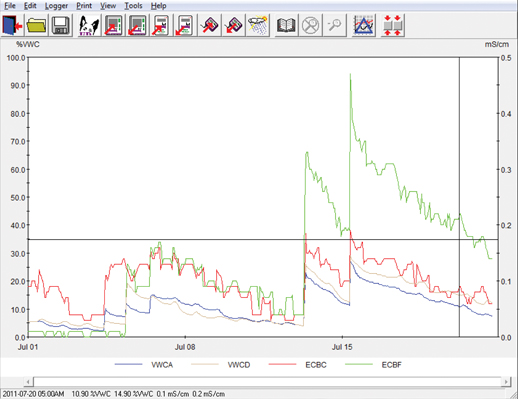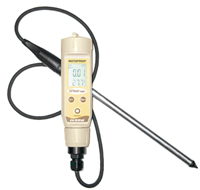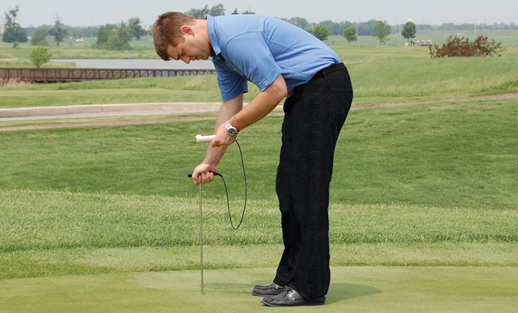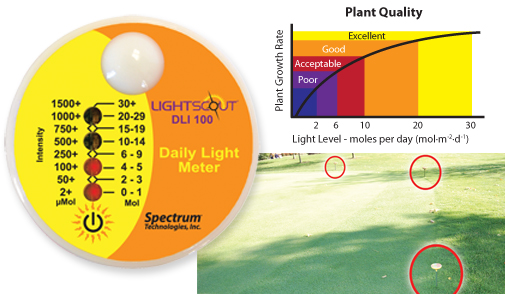|
Welcome Back, Doc!
Doc Green is back from a short sabbatical talking with greenhouse plants across the country and he has brought back the following turfgrass products and turfgrass salinity information to share with you.
Never miss our newsletter again! Your plants are trying to talk to you, make sure you don’t miss the message! “If Plants Could Talk” is full of industry specific information and tips to help you make profitable decisions.
This Month's Topic: Salinity Problems in Turfgrass!
Don’t wear yourself out while managing your greens. Use these precision tools to maintain the best daily playing conditions and make your job less stressful. With Spectrum tools, measuring is quick and easy!
Salinity Problems?
In arid regions, salts have the tendency to build up in the upper soil layer because annual precipitation is not sufficient to move them below the root zone. Even in moist soils, rigid soil layers, such as clay hardpans can impede the downward movement of these salts. Because of this, one of the more difficult problems facing turfgrass managers in arid and semi-arid climate zones is the accumulation of salts in rootzones. The buildup of salt results from irrigation with low quality saline water combined with insufficient leaching through rainfall. To maintain adequate turf quality, continuous monitoring of soil moisture and salinity in the rootzone is necessary. Consequently, excess salinity and/or sodium in turfgrass typically leads to poor turf performance, reduced water infiltration and even the emergence of turfgrass diseases
Soil salinity indicators:
-
White crust or crystals on dry soil surfaces
-
Patches of reduced growth or yield in areas
-
Tip burning of leaves, followed by yellowing and bronzing
-
Subsoil appears wet after harvest, even when the finish was dry
-
A noticeable increased of salt tolerant weeds
-
Death of some trees and clover may appear
-
Bare scalded areas develop and increasingly gets bigger
-
Shallow watertable is noticeable in pits
-
Friable or ‘puffy’ soil structure in low-lying areas when dry
-
Damp patches in otherwise dry soil
-
The occurrence of bicarbonate salts associated with very high pH values (> 9) may be associated with ‘black alkali’ (greasy-looking black patches) linked to the dispersion of organic matter – also with white “magnesia patches”
Electrical Conductivity (EC)
Turfgrass salinity problems can be difficult to diagnose and manage because the soluble salts in the soil restrict plant growth. A high level of soluble salt reduces water intake by plant roots. When this happens, the plant is then subjected to drought conditions even when soil moisture is sufficient. As a result, the plant cannot take up sufficient water and reduced growth or death may occur resulting in diminished turf quality and revenue loss for golf courses. Soluble salts typically consist of carbonates, bicarbonates, sulfates, chlorides, and nitrates combined with calcium, sodium, magnesium, potassium, and other minerals. Salt accumulates from fertilizers, irrigation water, and the natural breakdown of soil minerals.
Inadequate leaching and inherited salinity are the two main effects of salt problems in turf production systems. Inadequate leaching is the leading cause for the majority of salinity problems. Irrigation repeatedly adds salts to soils, resulting with the salts to accumulate to damaging or toxic levels if leaching does not try eliminating them. Leaching occurs when a portion of applied water penetrates below the root zone and in turn is no longer available for plant uptake resulting with the leachate carrying away the damaging salts. When the water supply for irrigation is insufficient to support proper leaching, salinity levels rise and eventually turf performance and/or soil structure declines.

Track water, salts, and soil temperature: all with a single sensor!
With the Spectrum WaterScout SMEC 300 Soil Moisture/EC/Temperature Sensor, turf managers can monitor for high salt levels on golf course greens and determine when to flush (leach) salts before turf quality declines. Use this portable EC meter and probe to measure salinity in turf right on the spot without tedious soil sampling and preparation. Turf managers can compare readings from plant to plant and fine-tune their turf management program. The meter comes with the FieldScout Soil/Water EC probe. This single stainless steel probe has a specially designed conical tip. It can measure liquid EC (water or nutrient solutions) or in-situ soil salinity. The probe automatically compensates for temperature.
The SMEC 300 measures EC with a pair of carbon ink electrodes that provide a large contact surface with the soil solution. Temperature is measured with a thermistor potted in the sensor molding. The SMEC 300 is designed to be compatible with the WatchDog data loggers and weather stations as well as the FieldScout soil sensor reader. SpecWare™ software enables you to view your data in graphical and tabular form as well as run reports customized to your application.
Product Features:
-
Capacitance-type soil moisture sensor
-
Carbon ink electrodes provide large measuring surface for EC
-
Easy, 1-step EC calibration process
-
Can be read with the FieldScout Soil Sensor Reader (Item 6466) or WatchDog 2000 and 1000 Series Stations
-
Connect up to 2 sensors per station (depending on model)

The EC sensor can be calibrated with a simple, 1-step process. Use the available hand-held reader to take fast and accurate spot readings. Or you may choose to bury the sensor and track soil moisture changes over time with the WatchDog data-logging weather station.
The sensors should be located in the effective root zone and the depths will give a representative picture of the salinity and soil water status of the area being measured. This could be fairways vs. greens or tee areas. Areas with significant differences in factors such as topography or soil type should be considered unique environments.

You can collect data and log results when the WaterScout SMEC 300 Sensor is connected to a WatchDog Station.

Instant and Accurate Direct EC Measurement
With the Spectrum FieldScout Direct Soil EC Meter, provides measurements for golf course greens following irrigation or deep-soaking rain events. Probe to the depth of the turf root zone. Measurements exceeding 0.7 mS/cm (approximately equivalent to 2.7 mS/cm in a saturated paste extract) will result in cool season turf grass stress. The meter comes with the FieldScout Soil/Water EC probe. This single, stainless steel probe has a specially designed conical tip. It can measure liquid EC (water or nutrient solutions) or in-situ soil salinity. The probe automatically compensates for temperature. 
Product Features:
-
Patented paired sensor tip provides maximum soil-sensor contact and higher accuracy
-
Sample directly in turfgrass to get readings
-
0 to 19.9 mS/cm (Accuracy 2%, resolution 0.01 mS/cm)
-
Automatic temperature compensation
-
Includes battery and EC calibration standard
When taking direct-insert EC readings in turf grass with the FieldScout meter, it is often helpful to convert the measurement to the equivalent Saturated Media Extract (SME) value. This conversion will vary for different soils. For sandy soils, the expression: SME = 2.7FS 0.8 provides a good approximation. FS refers to the reading taken by the Field Scout meter. This equation is the basis for table 1. Table 2 lists a variety of grass species and the range of EC values (converted to SME) they can tolerate.

FieldScout Direct Soil EC Meter shown with optional 24in T-Handle.


Why Light Measurement?
If photons were raindrops, light meters would show the intensity of a rainstorm. A five-minute rainstorm may look impressive, but often providesless waterthan an all-day drizzle. As cumulative rainfall is measured with a rain gauge, the cumulative quantity of light is measured using a light meter. The daily total of quantum light is called the Daily Light Integral, or DLI, and is measured in units of mol/m2day. DLI quantifies the light available to plants to perform photosynthesis.

The LightScout DLI 100 Meter is a simple way to monitor shaded or full sun golf greens. Sold in sets of three to easily compare light intensity levels in separate locations. With a push of a button, the DLI 100 Meter records light intensity for a 24 hour period and then calculates the Daily Light Integral (DLI). Real-time intensity levels are shown every 4 seconds in �mol m-2 s-1 (or footcandles).
Product Features:
-
Compare light between three locations, simultaneously
-
Simple, one button operation
-
Displays light intensity levels every 4 seconds for 24 hours
-
An affordable, first step in measuring light
-
Measure PAR light (Photosynthetically Active Radiation)
-
With the push of a button, the meter runs for 24 hours and calculates your Daily Light Integral (DLI)
-
Real-time intensity levels are shown every 4 seconds in �mol m-2 s-1 (or footcandles)
-
Packaged in sets of 3 light meters, or individually

This year marks our 25th year of doing business!

We want to thank the many researchers and customers who have contributed to our success. We look forward to serving and working with you on our continued goal to be the partner you can count on for affordable Plant Measurement Technology.
|